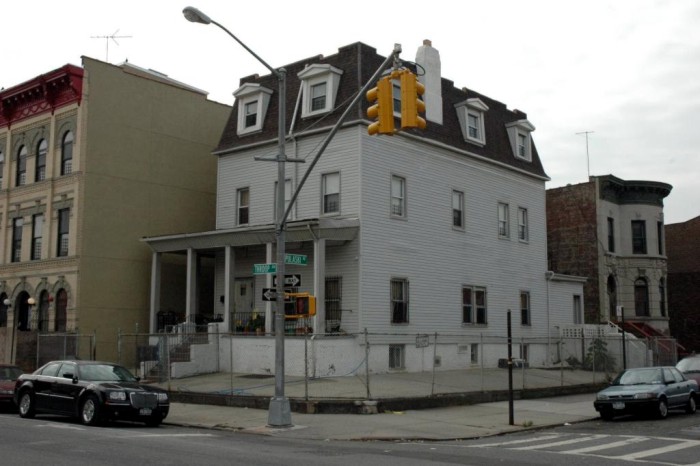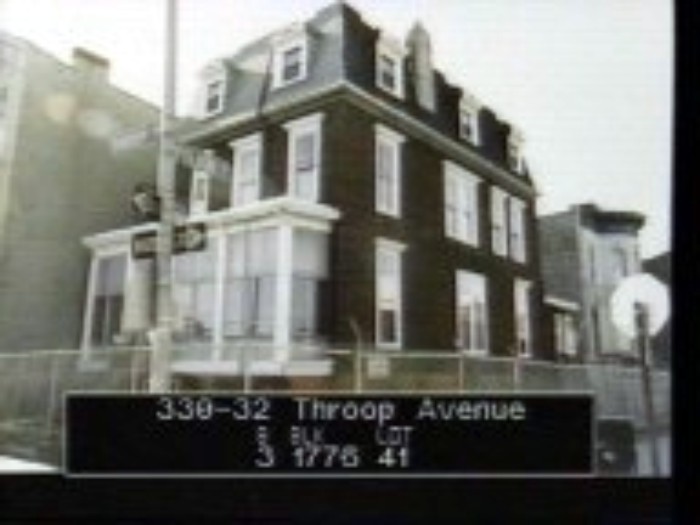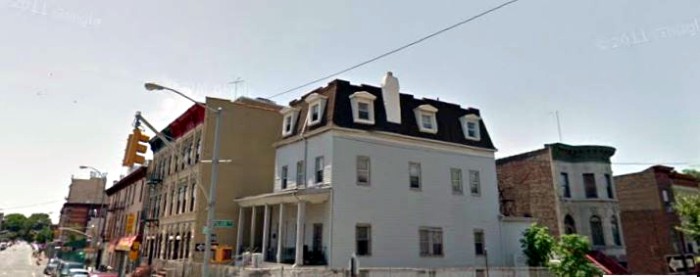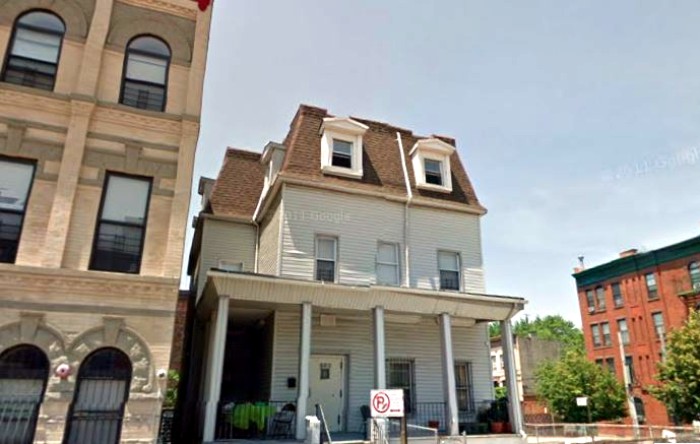Building of the Day: 330 Throop Avenue
Brooklyn, one building at a time. Name: Private house Address: 330 Throop Avenue Cross Streets: Corner Pulaski Street Neighborhood: Bedford Stuyvesant Year Built: Sometime before 1873 Architectural Style: Second Empire Architect: Unknown Landmarked: No The story: A house doesn’t have to be a grand mansion in order for a lot to have gone on inside. In…


Brooklyn, one building at a time.
Name: Private house
Address: 330 Throop Avenue
Cross Streets: Corner Pulaski Street
Neighborhood: Bedford Stuyvesant
Year Built: Sometime before 1873
Architectural Style: Second Empire
Architect: Unknown
Landmarked: No
The story: A house doesn’t have to be a grand mansion in order for a lot to have gone on inside. In fact, there are grand mansions that I haven’t been able to find any information on, in spite of them being large, obvious houses of people of means, who usually ended up in the papers, somehow, somewhere. Sometimes people lead quiet, almost secretive lives, and we’ll never know anything about them, except for the buildings they leave behind. And then you get houses that have seen it all. Life and death took place there, and the building, because of its size or location or inhabitants, are the stuff of stories. 330 Throop Avenue, in Bedford Stuyvesant, is one of those houses.
The house was built sometime before 1873, probably for the first owner I found any record of: a prominent lawyer named J.L. Marcellus, of the firm Marcellus & Lowry. In 1873 Mr. Marcellus was appointed to the Board of Education of Brooklyn. At that time, this part of Bedford was just beginning to be developed. It was still home to free-standing villas, of a suburban nature, many owned by nearby brewers and businessmen from Bushwick and Williamsburg. This area still has many remaining free standing houses, an amazing amount, considering the developmental and economic history of the area.
By 1897, the house belonged to Dr. Clinton W. Willis. He and his two of his three brothers, and his uncle were all medical doctors, but that didn’t help their youngest brother. He came to visit Dr. Willis, here at 330 Throop Avenue, and suffered a seizure and died, despite his brother’s care. The young man, Amasa Willis, was only 19 years old, and had applied to Cornell University to study medicine. He never got there, but is now buried in Green-Wood Cemetery.
For some reason, this house was home to not one, but two separate and unconnected suicides. In 1905, a young starving artist named Max Bachman, who had only arrived in the city recently, had rented a furnished room here. He was 22 years old. He took his own life in his room, hanging himself from a rope that he had tied to an eye screw in the ceiling. He hung there for hours until he was discovered by a friend who had come to visit. Much later, in 1937, store owner Louis J. Rubin also lived here, and he killed himself in the same way, in his room. He was a dry goods merchant with a shop at 480 67th Street, in Bay Ridge. Kinda creepy, actually.
But it was not all sorrowful here at 330. Many good things happened here, as well. The house’s medical good vibes translated into a children’s clinic that operated here in 1914. After the clinic moved out, the building became a sports club called the Parnell Club. They also hosted meetings by other organizations, including political rallies and meetings between sports clubs. They had the building from at least 1918 until the mid-1920s.
The house seems to have gone back to residential use after the Parnell Club left, and was home to various and sundry ordinary folk who lived, got married, had careers, and died. The last newspaper story I found about this house was a good one. Two year old Robert Sigman was playing in the living room of his parent’s apartment in the house, as his mother, Anna, prepared him and his brother for a shopping trip downtown. She turned away for a second, as the other child distracted her, and when she turned around, the toddler had crawled out the third floor window, and was on the ledge. She rushed to the window, which made the child go out further, and he slipped off the ledge, and was dangling over the edge.
Passersby saw the child in the window, and called for the police and fire department. Fortunately, a policeman was nearby, as was a fireman from a nearby company. He had been in a nearby store, and both men rushed to the house, and got there at the same time. The patrolman ran into the house to try to get the child from the inside, while the fireman, 26 year old George Stumpf, ran to the building and stood underneath, ready to catch the boy if he fell. No sooner had he gotten in position than the child lost his grip and fell…right into George Stumpf’s arms. The boy had just missed impaling himself on an iron fence. But all was well, he was unhurt, and George Stumpf chalked it up to “all in a day’s work.”
Today, 330 Throop Avenue no longer looks as it did when all of those stories took place. A look at the 1980s tax photo shows the house in asphalt siding. Today it’s covered in vinyl siding, and most of the building’s details are obscured. Except for the fact that it’s a stand-alone house in a neighborhood of row houses, you might not notice it at all. Next time you happen to pass this way, take a look. You never know the tales a house can tell. GMAP
(Photo:Nicholas Strini for PropertyShark)








Nice, I have always wondered about all of the grand old houses in that part of town. Sometimes I think the little stories like this are what make Brooklyn.
I agree… MM is bringing these stories back to life….